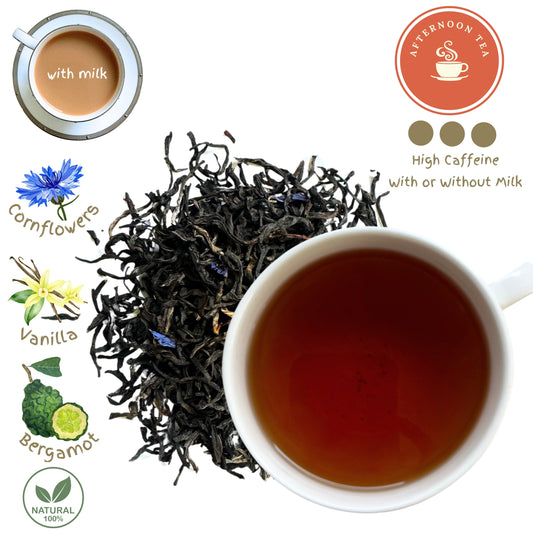Discovering the Essence of Ceylon Tea: A Journey Through Flavor and History
Ceylon tea, known for its exquisite taste and rich history, holds a special place in the world of tea enthusiasts. Originating from the lush hills of Sri Lanka, formerly known as Ceylon, this tea boasts a distinctive flavor profile that has captivated tea lovers for centuries. In this blog article, we delve into the origins, production, and cultural significance of Ceylon tea, exploring what makes it a cherished beverage globally.
Origins and History of Ceylon Tea:
The story of Ceylon tea begins in the 19th century when the British introduced tea cultivation to Sri Lanka, then known as Ceylon, as an alternative to coffee production, which was devastated by disease. The island's favorable climate, high elevations, and fertile soil proved ideal for growing tea. The first tea plant was brought to Sri Lanka in 1824 by a British planter named James Taylor, marking the beginning of the island's illustrious tea industry.
Tea cultivation in Ceylon initially faced challenges, but with Taylor's perseverance and experimentation, the industry began to flourish. By the late 19th century, Ceylon had become one of the world's leading tea producers. Today, tea plantations cover vast swathes of the island's central highlands, with regions like Nuwara Eliya, Kandy, and Dimbula renowned for their exceptional teas.
Ceylon Tea Production Process:
Ceylon tea is predominantly made from the Camellia sinensis var. assamica and Camellia sinensis var. sinensis tea bushes, which thrive in the island's diverse microclimates. The production process typically involves several stages, each crucial in shaping the final flavor and quality of the tea.
- Tea leaf plucking: Skilled tea pluckers carefully hand-pick the tender two leaves and a bud from the tea bushes. This meticulous process ensures that only the freshest and highest-quality leaves are harvested.
- Tea leaf withering: The freshly plucked leaves are spread out on withering troughs or racks, exposing them to warm air. This withering process reduces the moisture content of the leaves, making them pliable for further processing.
- Tea leaf rolling: The withered leaves undergo rolling, breaking down the cell walls and initiating oxidation. Traditionally, rolling was done by hand, but modern tea factories employ machinery for efficiency while ensuring the delicate handling of the leaves.
- Tea leaf oxidation: Following rolling, the leaves are spread out in a controlled environment to undergo oxidation. This crucial step allows the natural enzymes in the leaves to interact with oxygen, resulting in the development of flavor compounds and aromas.
- Tea leaf firing: Once the desired oxidation level is achieved, the leaves are subjected to high temperatures to halt oxidation. This step, known as firing or drying, preserves the tea's flavors and aromas.
- Ceylon tea leaf sorting and grading: After firing, the tea undergoes sorting and grading based on leaf size, appearance, and quality. This ensures consistency in flavor and appearance across different batches of tea.
Ceylon Tea Flavor Profile:
Ceylon tea is celebrated for its versatility and diverse flavor profiles, which can vary depending on factors such as altitude, terroir, and manufacturing techniques. Generally, Ceylon teas are characterized by their bright, brisk flavors, with a well-balanced combination of floral, citrus, and malt notes.
Ceylon teas from higher elevations, such as Nuwara Eliya, are prized for their delicate and fragrant profiles, often exhibiting floral and citrus undertones. In contrast, teas from the lowlands tend to be fuller-bodied with robust flavors, making them ideal for blending or serving with milk.
Varieties of Ceylon Tea:
Ceylon tea comes in various grades and types, offering a unique taste experience. Some of the popular varieties include:
- Ceylon Black Tea: The most common type of Ceylon tea, black tea is known for its robust flavor and dark liquor. It is often enjoyed plain or with a splash of milk and sugar.
- Ceylon Green Tea: Ceylon green tea is prized for its fresh, grassy flavors and delicate aroma. It undergoes minimal oxidation, preserving the natural antioxidants and health benefits present in the tea leaves.
- Ceylon White Tea: Considered the most delicate and rarest type of Ceylon tea, white tea is made from young tea buds and undergoes minimal processing. It boasts subtle floral notes and a light, refreshing taste.
- Ceylon Oolong Tea: A relatively rare variety in Sri Lanka, oolong tea undergoes partial oxidation, resulting in a unique flavor profile that falls between black and green tea. It offers complex flavors with hints of fruit and floral undertones.
Cultural Significance of Ceylon Tea
Tea plays a significant role in Sri Lankan culture and society. Ceylon tea is a source of national pride and identity. Sri Lanka is one of the world's largest tea exporters, with the tea industry contributing significantly to the country's economy and providing livelihoods to thousands of people.
Tea is deeply ingrained in Sri Lankan customs and rituals, from the daily tradition of afternoon tea to religious ceremonies and social gatherings. In rural areas, tea cultivation is a way of life for many families, with generations of expertise passed down through the years.
Beyond its economic importance, Ceylon tea holds a special place in the hearts of Sri Lankans and tea enthusiasts worldwide, serving as a symbol of hospitality, warmth, and tradition.
Ceylon tea is a testament to the artistry and craftsmanship of tea production, blending tradition with innovation to create a beverage that delights the senses and nourishes the soul. From its humble beginnings in the hills of Sri Lanka to its global acclaim, Ceylon tea continues to enchant tea lovers with its unparalleled flavor, diversity, and cultural significance. As we savor each sip of this exquisite Manasa Tea brew, we embark on a journey through time and taste, celebrating the legacy of Ceylon tea and the rich tapestry of its origins.










